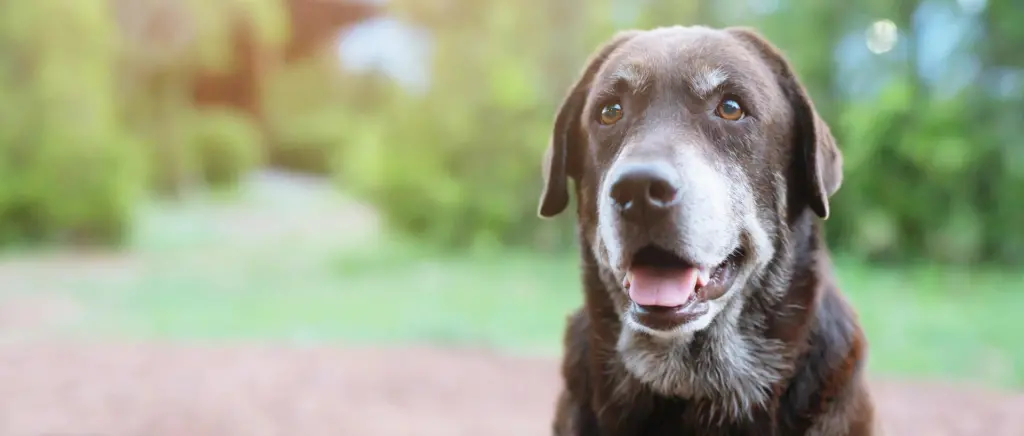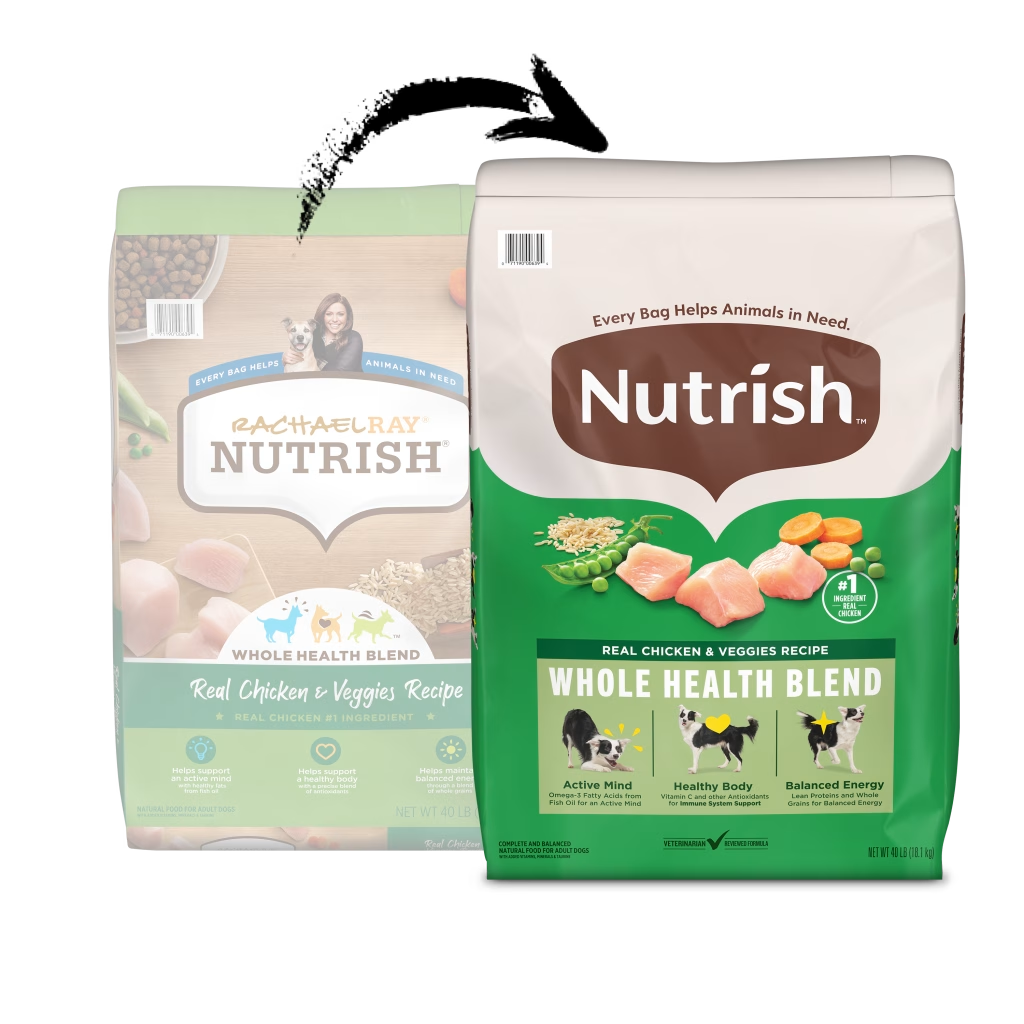As your dog tail-wags her way through adulthood, it’s only natural to start looking for signs of aging. You might think that just knowing your dog’s age will be enough to determine when she’ll start going gray or slowing down on walks. In truth, figuring out when your dog could be considered a senior depends on a lot of different factors. Read on to learn more about senior dogs, signs of aging and how you can keep your old dog happy as can be throughout her golden years.
At What Age Is a Dog Considered a Senior?
Dog aging has a ton of variation from one pup to the next. There are all sorts of environmental factors that can play a role in how quickly your dog ages. For example, a dog given too much food may become obese. Obesity can lead to health complications like heart disease or arthritis that could shorten their lifespan or lessen their quality of life. Other factors like pollutants in the air or drinking water could accelerate certain health problems and shorten lifespan as well.
Disregarding environmental factors, breed and size are the most important indicators of when your dog would be considered a senior. In general, large and giant breeds mature more slowly but have shorter lifespans, reaching senior status around 6-7 years of age. Toy and small breeds are the opposite, maturing quickly but not reaching senior status until around 10-12 years of age. Medium breeds tend to fall somewhere in the middle, entering their golden years between ages 8 and 9.
So, is a 7-year-old dog a senior? If it’s a Great Dane, the answer is yes. If it’s a Jack Russell Terrier, probably not. Either way, the older your dog gets, the more important it is to get her to the vet for semi-annual visits. This will help you and your vet keep tabs on any aspects of your dog’s health you may be concerned about and catch any age-related complications sooner rather than later.
Comparing Dog Years to Human Years
It’s fun to try figuring out dog age in human years, but the equation you’re probably familiar with—one dog year equals seven human years—isn’t the most accurate. While dogs go through similar life stages to humans (infancy, adolescence, etc.), they do so in a much more compressed timeline. Some developmental periods also happen faster than others. According to a study from the National Institutes of Health (NIH), published in the journal Cell Systems, dog age ranges correlate to the following human age ranges:
| Life Stage | Dog Age | Human Age |
| Juvenile | 2–6 months | 1–12 years |
| Adolescent | 6 months–2 years | 12–25 years |
| Mature | 2–7 years | 25–50 years |
| Senior | 12 years | 70 years |
As an example, Labrador Retrievers hit full maturity around two years of age. The 1:7 ratio dictates that a two-year-old lab would be around 14 in human years, but from a developmental standpoint they’d actually be closer to 25!
The equations needed to calculate your dog’s age in human years are a bit more complex than the 1:7 ratio. But these age ranges can provide a more accurate picture of where your dog’s maturity level would be if she walked on two legs instead of four.
Signs That Your Dog Is Getting Old
There’s a lot more to getting old than going gray and having more candles on the birthday pup-cake. Keep an eye out for the following mental, physical and physiological signs that your pup may be reaching senior dog territory.
- Changes in Activity or Mobility
Many dogs develop joint problems or arthritis as they age, which can leave them feeling less than eager to play fetch or go on long walks. They may also have trouble going up and down stairs or hopping into the car for rides. Pay attention to how your dog moves in the morning or after a long rest—if she has a hard time getting up and walks around stiffly, let the vet know as soon as possible. Your vet can identify if your dog is developing a degenerative disease and make recommendations to help keep her moving comfortably.
- Weight Gain or Loss
If your dog isn’t as active as she used to be, she may gain weight if you don’t adjust her diet. Obesity can worsen mobility issues and cause other health problems, so it’s important to talk to your vet about ways to keep her weight in check.
On the other hand, some older dogs lose weight. A diet change could help in this instance, too. If your dog has rapidly lost a lot of weight, take her to the vet to see if an underlying health issue is to blame.
- Digestive Issues
Dogs’ ability to digest protein and fat can lessen over time. If your dog is gassier than usual or has overly soft stools, she could need a diet change. Get your vet’s recommendations for easily digestible foods made with higher quality proteins.
- Sleep Changes
Many dogs take short naps during the day and sleep for most of the night. As your dog ages, you might notice a shift in these patterns. She may be restless during the night, waking up several times and even pacing around. If your dog also seems confused or disoriented during the day, have your vet examine her for signs of cognitive decline or dementia.
- Vision Problems
Do your dog’s eyes look cloudy? Nuclear sclerosis, or eye cloudiness, can naturally occur as dogs age. But vision decline isn’t always associated with eye cloudiness. If your dog seems to have trouble noticing things right in front of her or bumping into walls and furniture, she could be experiencing vision problems. Some eye issues like cataracts are treatable, so be sure to talk to your vet about next steps.
- Tooth Decay & Oral Problems
If your dog has some truly stinky breath, she could be experiencing tooth and gum problems. Your vet should be able to help clear up an infection, but tooth loss and gum disease aren’t so easy to deal with. To prevent these problems later down the line, it’s important to give your dog regular teeth cleanings and brushings throughout her life.
- Temperature Intolerance
Brachycephalic dogs like Pugs and Bulldogs often struggle in the heat throughout their lives due to their short snouts, which make it harder for them to regulate their body temperature. The struggle only gets harder as they age, so be sure to keep your short-snouted pals cool and comfortable.
Other dogs have a harder time keeping warm as they get older. This could be due to hypothyroidism, which can cause your dog to lose body heat. Make sure to keep her out of the cold as much as possible and give her plenty of comfy pillows and blankets to cozy up in.
How to Care for an Old Dog
Keeping your senior dog comfortable is an important job. Here are several ways to address your elderly dog’s evolving needs.
- Diet Changes
Whether you’re keeping your dog’s weight in check or looking for ways to manage her reduced digestive capacity, a diet change may be the most effective solution. In some cases, you may just be able to increase or decrease the amount of food you’re already giving her. Have a discussion with your vet about serving sizes and which recipes or formulas might be the right fit for your dog.
- Temperature Protection
If your dog can’t beat the heat the way she used to, do your best to keep her cool. Don’t bring her along to outdoor events where she would be in the heat and sunlight for hours on end. If you do go on a summertime outdoor adventure, bring plenty of water and take frequent breaks to cool off in the shade.
Being chilly is the problem? As we mentioned, giving her plenty of plush bedding and warm blankets could help keep her cozy. Make sure her favorite sleeping spots aren’t exposed to drafts that could sap her body heat.
- Accessibility
Helping your dog continue to do her favorite things as her mobility level changes is key to keeping her happy. Investing in step stools or stairs will help her join you on the couch, in bed or in the car even when she’s no longer able to hop up.
- Avoiding Pressure Sores
If your dog becomes thinner, she could develop pressure sores on the bony parts of her body from laying on hard surfaces for long periods of time. Adding more cushions or dog beds to the house can help avoid this problem. If she does develop pressure sores, get her to the vet for treatment to avoid bacterial infections due to open wounds.
- Activity Changes
Your dog might not be able to play some of her favorite games anymore, or at least not for as long. If your dog has arthritis or joint problems that make it difficult for her to take walks, consider getting a stroller or wagon to pull her around the neighborhood or her favorite park. Puzzle or seeking games can also be low-impact, entertaining ways to keep your dog’s mind sharp. Hide pieces of her favorite treats around the house so she can sniff them out. Or, put pieces of kibble in a puzzle toy and let her work out ways to use her snout and paws to earn a tasty reward.

